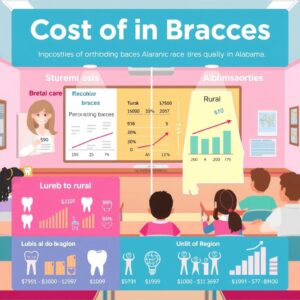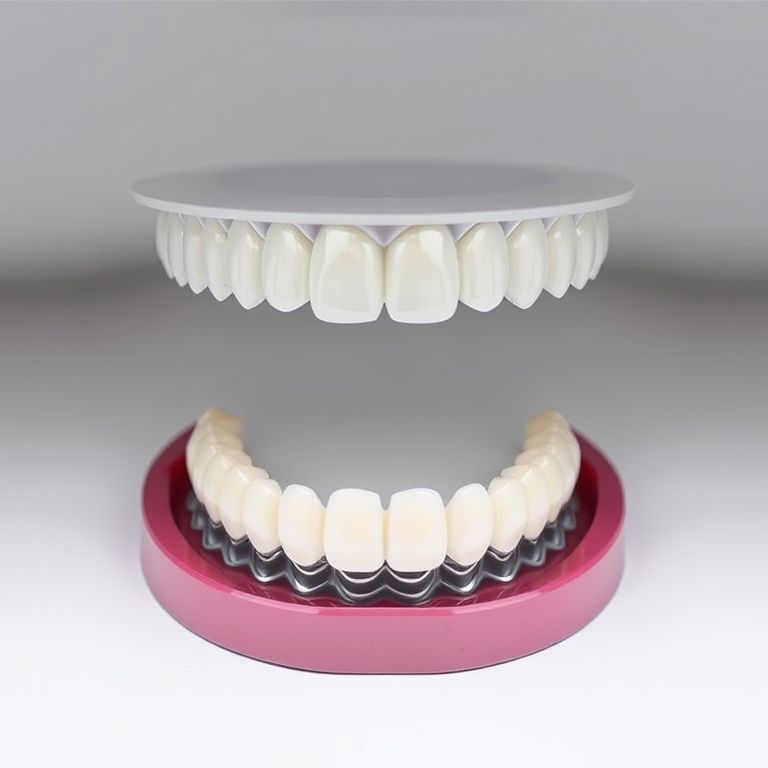The Ultimate Guide to the Cost of Braces in Alabama
A confident smile is a universal asset, a non-verbal communicator of health, happiness, and self-assurance. For many Alabamians, achieving that ideal smile involves orthodontic treatment—a journey often perceived as daunting, primarily due to the associated costs. The question “How much do braces cost in Alabama?” is not a simple one to answer. It’s a multifaceted equation influenced by geography, technology, clinical expertise, and individual needs. This guide aims to demystify that equation. We will move beyond a single number and delve into a comprehensive exploration of orthodontic investments in the Heart of Dixie. Whether you’re a parent considering braces for your child or an adult exploring options for yourself, this resource is designed to equip you with the knowledge to make an informed, confident decision about this significant investment in your oral health and overall well-being. This is not just about straightening teeth; it’s about unlocking a future of improved function, health, and confidence.

2. Understanding the “Why”: The Benefits of Orthodontic Treatment
Before examining the cost, it’s crucial to understand the immense value orthodontic treatment provides. It is a medical investment with lifelong dividends.
Health Benefits Beyond Aesthetics
-
Improved Oral Hygiene: Crooked or crowded teeth create hard-to-reach havens for plaque and bacteria. Straight teeth are significantly easier to brush and floss effectively, drastically reducing the risk of cavities and gum disease (periodontitis), which is a leading cause of tooth loss in adults.
-
Prevention of Tooth Wear: Misaligned teeth often cause abnormal wear, where certain teeth bear more force than they are designed to handle. This can lead to chipping, cracking, flattening, and enamel erosion. Orthodontics corrects the bite, distributing force evenly.
-
** Jaw Pain and TMJ Relief:** Malocclusions (bad bites) like overbites, underbites, and crossbites can place excessive stress on the jaw joint and muscles. This can lead to chronic pain, headaches, temporomandibular joint disorder (TMD), and even difficulty opening and closing the mouth. Proper alignment alleviates this strain.
-
Improved Digestion: Teeth are the first step in the digestive process. A proper bite allows for effective chewing, breaking down food into more manageable pieces for your stomach, thereby aiding digestion.
-
Speech Improvement: Certain orthodontic issues, like significant gaps or misalignments, can interfere with tongue placement and cause speech impediments like lisps. Correction can lead to clearer speech.
Psychological and Social Advantages
-
Boost in Self-Esteem and Confidence: This is often the most immediate and noticeable benefit. A smile you are proud of can transform social interactions, professional opportunities, and overall self-perception.
-
Reduced Social Anxiety: Many individuals with misaligned teeth feel self-conscious and may avoid smiling, laughing, or speaking in public. Orthodontics can remove this source of anxiety.
-
Long-Term Financial Savings: By preventing future dental problems like gum disease, excessive wear, and jaw issues, orthodontic treatment can save you thousands of dollars in potential restorative dental work, crowns, root canals, and even oral surgery down the line.
3. A Primer on Orthodontic Options: What Are You Paying For?
The type of appliance you choose is one of the most significant factors affecting the total cost. Each option comes with its own set of advantages, disadvantages, and price points.
Traditional Metal Braces
-
Description: These are the most common and recognizable type of braces. They consist of high-grade stainless steel brackets bonded to the front of the teeth, connected by an archwire. Small elastic bands (ligatures) hold the wire in place.
-
Modern Advancements: Today’s metal braces are smaller, less conspicuous, and more comfortable than ever. They also often use self-ligating brackets that have a built-in clip instead of elastics, which can reduce friction and potentially shorten treatment time.
-
Pros: Most effective for complex cases, durable, least expensive option.
-
Cons: Most noticeable, can cause irritation to cheeks and gums, require dietary restrictions.
Ceramic (Clear) Braces
-
Description: These function identically to metal braces but use tooth-colored or clear ceramic brackets that blend in with the natural tooth color. The archwire can also be coated to be less noticeable.
-
Pros: Much more aesthetically pleasing than metal, effective for a wide range of cases.
-
Cons: More expensive than metal, brackets are larger and can be more brittle, may stain if not cared for properly (especially the elastic ligatures).
Lingual Braces
-
Description: These are the ultimate “invisible” brace. They are custom-made metal braces that are bonded to the back (lingual side) of the teeth, making them completely hidden from view.
-
Pros: Completely invisible from the front, effective for complex cases.
-
Cons: Most expensive type of brace, can be more uncomfortable for the tongue initially, may affect speech temporarily, more challenging to clean, not suitable for all cases.
Clear Aligners (Invisalign & Alternatives)
-
Description: This treatment involves a series of custom-made, removable, clear plastic trays that gradually shift the teeth. Brands like Invisalign are the most well-known, but many orthodontists offer their own comparable systems (e.g., Spark, ClearCorrect).
-
Pros: Nearly invisible, removable for eating, brushing, and flossing, no dietary restrictions, typically more comfortable than braces with less irritation.
-
Cons: Requires extreme patient compliance (must be worn 20-22 hours per day), not ideal for all types of movements (e.g., large rotations, extrusions), can be lost or broken, often comparable in cost to ceramic braces.
4. Breaking Down the Cost: What Factors Influence the Price of Braces in Alabama?
The total fee you are quoted is not arbitrary. It is a carefully calculated sum based on several key variables.
-
Complexity of the Case: A simple case of minor crowding in a teenager will cost far less than the comprehensive treatment required for an adult with a severe overbite, crossbite, and impacted canines. The more complex the problem, the more skill, time, and auxiliary appliances (like expanders or headgear) are required.
-
Type of Appliance Chosen: As outlined above, the technology itself carries different price tags. Metal is generally the baseline, with ceramic, clear aligners, and lingual braces commanding premiums for their aesthetic benefits.
-
Orthodontist’s Experience and Location: A highly experienced, board-certified orthodontist in a major metropolitan area like Birmingham or Huntsville will typically charge more than a general dentist offering orthodontics in a rural community. Expertise, overhead costs (office rent, staff salaries), and local market rates all play a role.
-
Treatment Duration: The estimated length of treatment is factored into the cost. A 12-month treatment will generally cost less than a 30-month treatment, though this is tied directly to case complexity.
-
Initial Consultation and Diagnostic Records: The fee often includes the initial consultation, panoramic X-rays, cephalometric films, photographs, and digital scans or physical impressions needed to create a precise treatment plan. These are essential for an accurate diagnosis and are a fixed cost.
5. The Alabama Price Landscape: A Detailed Cost Analysis
It is important to remember that these figures are estimates. The only way to get an accurate price is through a consultation with an orthodontist. Costs can vary widely across the state.
Average Cost Ranges by Type
The following table provides a general overview of what you might expect to pay for comprehensive orthodontic treatment in Alabama. These are statewide averages for full treatment, not monthly payments.
| Treatment Type | Average Cost Range in Alabama | Key Considerations |
|---|---|---|
| Traditional Metal Braces | $3,500 – $7,500 | Most cost-effective; ideal for complex cases. |
| Ceramic (Clear) Braces | $4,500 – $8,500 | Aesthetic alternative to metal; may stain. |
| Lingual Braces | $8,000 – $12,000+ | Most discreet fixed option; high cost; not for all. |
| Clear Aligners (Invisalign) | $4,000 – $8,500 | Removable and nearly invisible; requires discipline. |
Table 1: Estimated Cost of Braces in Alabama by Treatment Type
Cost Comparison: Urban vs. Rural Alabama
-
Urban Areas (Birmingham, Huntsville, Mobile, Montgomery): Practices in these cities often have higher overhead and may cater to a clientele with higher disposable income, leading to costs that trend toward the higher end of the ranges above.
-
Suburban and Rural Areas (Dothan, Decatur, Florence, smaller towns): Operating costs are generally lower, and competition might drive prices down slightly. It’s not uncommon to find high-quality care at the lower to mid-range of the estimates. However, access to providers offering the full spectrum of options (like lingual braces) may be more limited.
6. Navigating the Financials: How to Pay for Braces in Alabama
Few people pay the entire cost of braces upfront. Understanding your payment options is critical to making treatment affordable.
-
Dental Insurance and Orthodontic Coverage: Many dental insurance plans include an orthodontic benefit, often with a lifetime maximum (typically $1,000 – $2,500). Crucially, this benefit often has an age limit (e.g., under 19). It’s vital to check your specific plan details. Insurance will reduce your out-of-pocket cost but rarely covers the entire fee.
-
Flexible Spending Accounts (FSAs) and Health Savings Accounts (HSAs): These are fantastic tools for paying for braces with pre-tax dollars. You contribute a set amount from your paycheck before taxes are taken out. An FSA is “use-it-or-lose-it” within the plan year, while an HSA rolls over and is portable. You can use these funds to pay for your down payment or monthly installments, effectively giving you a discount equal to your tax rate.
-
In-House Payment Plans: Most orthodontic offices offer direct payment plans. This typically involves a down payment (often 20-30%) at the start of treatment, followed by monthly, interest-free payments for the duration of treatment. This is one of the most common and consumer-friendly ways to pay.
-
Third-Party Medical Financing: Companies like CareCredit and Alphaeon Credit offer medical credit cards. They often provide promotional periods with no interest if paid in full within a set time (e.g., 6, 12, 18, or 24 months). WARNING: If the balance is not paid in full by the end of the promotional period, you will be charged deferred interest on the original amount, which can be substantial. Read the terms carefully.
-
Discounts: Some offices may offer a small discount (e.g., 3-5%) for paying the entire fee in full at the start of treatment. Others may have discounts for military families, first responders, or multiple family members in treatment.
7. The Orthodontist Selection Process: Finding the Right Provider for You
Choosing an orthodontist is a personal decision. Do not base it solely on cost.
-
The Importance of Board Certification: An orthodontist is a dentist who has completed an additional 2-3 years of specialized residency training in orthodontics. A Board-Certified Orthodontist has gone a step further, voluntarily undergoing a rigorous examination process by the American Board of Orthodontics (ABO) to demonstrate their knowledge and clinical skills. This is the highest credential in the specialty.
-
Consultation Questions to Ask:
-
What are all my treatment options?
-
What is the total estimated cost, and what does it include? (e.g., retainers, emergency visits)
-
What payment plans do you offer?
-
How long is the estimated treatment time?
-
How often will I have adjustment appointments?
-
What is your policy for handling emergencies after hours?
-
-
Reading Reviews and Evaluating Testimonials: Look at Google Reviews, Facebook testimonials, and before-and-after photos of actual patients from the practice. This can give you insight into the patient experience and the quality of the results.
8. The Treatment Journey: What to Expect from Start to Finish
Understanding the process can alleviate anxiety and help you prepare.
-
The Consultation and Records Appointment: This is the information-gathering stage. The orthodontist will examine your teeth, discuss your concerns, and take diagnostic records (X-rays, photos, scans) to formulate a custom plan.
-
The Bonding Day: Getting Your Braces On: This appointment is typically the longest (1-2 hours). Your teeth will be cleaned and prepared, brackets will be precisely placed and bonded, and the archwires will be inserted. You’ll leave with care instructions and a kit containing wax, floss threaders, etc.
-
Adjustment Appointments: These occur every 4-8 weeks. The orthodontist will change wires, add elastics, or make other adjustments to continue guiding your teeth. These appointments are usually short (15-30 minutes).
-
Life with Braces: Diet, Hygiene, and Comfort: You’ll need to avoid hard, sticky, and chewy foods (popcorn, caramel, nuts). Oral hygiene is paramount; brushing after every meal and using specialized tools like water flossers and interdental brushes is essential. It’s normal to experience soreness for a few days after adjustments.
-
The Debonding Day: Getting Your Braces Off: A exciting day! The brackets are carefully removed, and the adhesive is polished off. Impressions or scans are taken for your retainers.
-
The Critical Phase: Retainers: This is the most important part of treatment. Teeth have a memory and will try to shift back. Retainers prevent this. You must wear them as directed, for life, to maintain your beautiful results. The cost of retainers is usually included in the initial treatment fee.
9. Pediatric vs. Adult Orthodontics: Key Differences in Cost and Treatment
-
Children/Adolescents: Treatment often occurs when most permanent teeth have erupted (ages 10-14). jaws are still growing, which can be advantageous for guiding development and preventing more severe problems later. Treatment may be slightly shorter and less expensive than comparable adult cases. Early interceptive treatment (Phase 1) can sometimes reduce the need for more extensive treatment later.
-
Adults: Orthodontics is increasingly popular among adults. While jaws are no longer growing, teeth can still be moved beautifully. Treatment can be more complex due to existing dental work (crowns, bridges), bone loss, or gum recession. It may require collaboration with other dental specialists (periodontists, oral surgeons). Treatment time can be longer, and costs can be higher. However, the benefits for health and self-esteem are just as profound.
10. Low-Cost and Charitable Options in Alabama
For those with significant financial constraints, options are available:
-
University Orthodontic Programs: The University of Alabama at Birmingham (UAB) School of Dentistry has a postgraduate orthodontic clinic. Treatment is provided by resident dentists under the supervision of experienced faculty at a significantly reduced cost. The trade-off is that appointments can be longer and treatment may take more time.
-
Donated Dental Services (DDS): This national program operates in Alabama and connects volunteer dentists and orthodontists with elderly, disabled, or medically-compromised individuals who cannot afford care.
-
Local Health Departments: Some county health departments may have information on low-cost dental clinics that occasionally provide or refer for orthodontic care, particularly for children with severe functional issues.
11. Conclusion: A Wise Investment for a Lifetime
The cost of braces in Alabama is a significant investment, typically ranging from $3,500 to over $8,500, influenced by treatment complexity and technology chosen. This expense, however, is an investment in long-term oral health, function, and immeasurable self-confidence. By understanding the factors that drive cost, exploring all payment options—from insurance and HSAs to payment plans—and choosing a qualified orthodontist, this life-improving treatment becomes an achievable goal for countless Alabamians.
12. Frequently Asked Questions (FAQs)
Q: What is the cheapest type of brace in Alabama?
A: Traditional metal braces are almost always the most affordable option.
Q: Does Medicaid in Alabama cover braces?
A: Alabama Medicaid (ALL Kids) may cover orthodontics for children only if it is deemed “medically necessary.” This does not include cosmetic issues. It is typically reserved for severe cases that affect function, such as cleft palates, major skeletal discrepancies, or traumatic injuries. Approval is very strict and requires prior authorization.
Q: How often are orthodontist appointments?
A: After the initial bonding, appointments for adjustments are usually scheduled every 4 to 8 weeks.
Q: Do braces hurt?
A: Braces do not “hurt” in a constant sense. You will experience pressure and soreness for a few days after they are first put on and after each adjustment. This is normal and manageable with over-the-counter pain relievers and soft foods.
Q: Can I get braces on just my top or bottom teeth?
A: While sometimes possible, it is rare. Teeth exist in a system, and moving only one arch without adjusting the other can create bite problems. Most orthodontists recommend full treatment to ensure a healthy, functional result.
Q: How long will I need to wear my retainers?
A: For life. The standard protocol is full-time wear (22+ hours/day) for the first 3-6 months after braces are removed, followed by nightly wear indefinitely. Teeth can shift at any age.
13. Additional Resources
-
American Association of Orthodontists (AAO): www.aaoinfo.org – Find a certified orthodontist and get consumer information.
-
American Board of Orthodontics (ABO): www.americanboardortho.com – Verify an orthodontist’s board certification status.
-
Alabama Medicaid: https://medicaid.alabama.gov/ – For information on ALL Kids coverage.
-
UAB School of Dentistry Orthodontic Clinic: https://www.uab.edu/dentistry/patient-care/clinics/orthodontics – For information on reduced-cost treatment.
14. Disclaimer
This article is intended for informational purposes only and does not constitute medical or financial advice. The cost estimates provided are averages and can vary significantly based on individual circumstances, specific orthodontist fees, and geographic location within Alabama. The information regarding insurance and programs is subject to change. It is essential to consult directly with a qualified orthodontist for a personal examination, accurate diagnosis, and a formal treatment plan and cost estimate. Always review the terms and conditions of any insurance plan or financial agreement carefully before committing to treatment.


